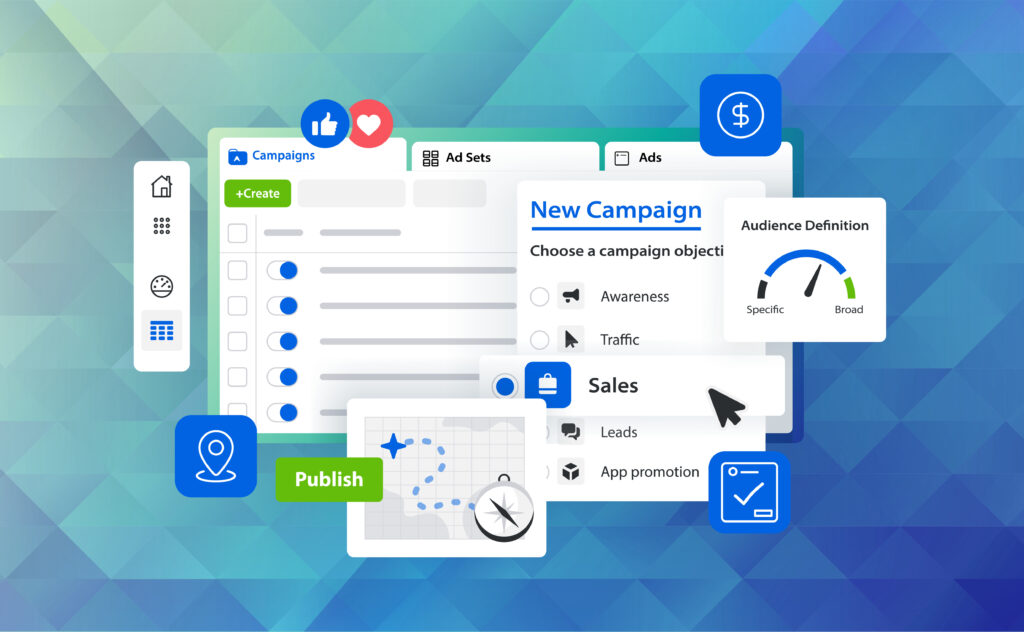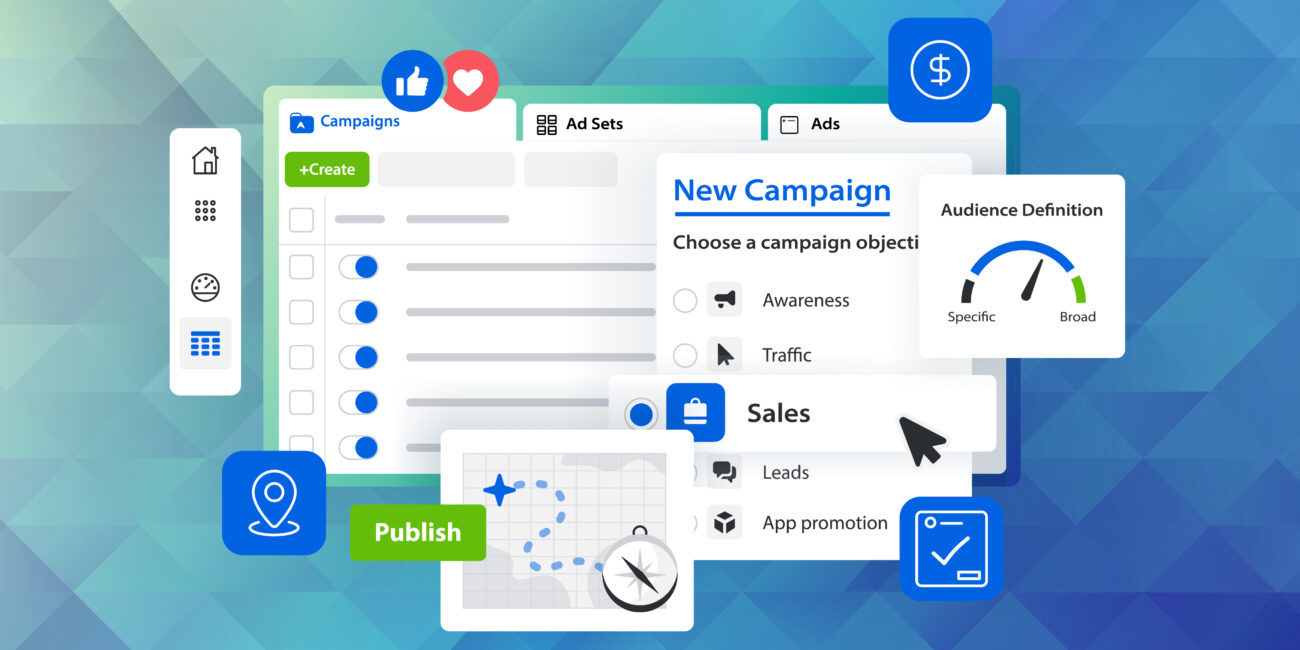In 2024, U.S. digital ad spending for the automotive industry is estimated to grow 11.1% to $21.22 billion, accounting for 7.2% of total digital ad spend. A thoughtful digital paid media strategy is now table stakes as more dealers and manufacturers fight for car buyer dollars across desktop and mobile devices. Meanwhile, recessionary pressures have pushed ROI to the forefront of advertising programs.
Industry averages, also known as benchmarks, are standardized metrics that represent the performance of marketing campaigns in a specific industry or category. They’ve become a key resource for marketers to prove that their campaigns are driving desired outcomes. In this article, we’ll explore how auto manufacturers and dealers can leverage digital paid media industry benchmarks to demonstrate that campaigns are performing above average and better than industry competitors.

Putting Campaign Effectiveness into Context
At a high level, industry averages give insight into how a “typical” industry campaign performs so that you have an accurate understanding of marketing efforts. A CPG brand, for example, will have dramatically different performance benchmarks than a software provider. It’s critical to measure performance within your industry’s context and not in a vacuum — against oneself and against competitors.
However, it’s important to note that industry benchmarks are constantly changing as trends arise, new companies enter the market, and the consumer landscape continues to evolve at record speed. When using industry benchmarks to assess performance, brands must consider the recency of benchmark data and the breadth of metrics they need to evaluate outcomes appropriately. To provide readers with the most up-to-date insights, we have focused on 2023 benchmarks based on digital campaigns running from the previous year.
Automotive Digital Marketing Benchmarks
To help auto manufacturers, dealers, and service providers understand and effectively apply paid search industry benchmarks to their campaigns, we’ll explore several key industry averages across the digital marketing funnel. These are broken down by vehicle sales and after-sales (repair, service, and parts) to provide context on how campaign evaluation should differ based on where your customers fall within the automotive ecosystem.
These 2023 paid search benchmarks and paid social benchmarks for Facebook, the most popular social media platform with an overall population, offer insight into how well campaigns should perform with the target automotive audience based on industry campaigns running from 2022-2023.
1. Click-Through Rates (CTR)
CTRs measure the percentage of users who click on an ad after seeing it, often providing insights into the effectiveness of ad creatives and messaging. If your CTR is below the benchmark, that may indicate a need for more compelling, targeted content.
Paid Search
Sales (Vehicles): 8.77%
After Sales (Repair, Service & Parts): 5.91%
Paid Social (Facebook)
Sales (Vehicles): 1.18%
After Sales (Repair, Service & Parts): 0.99%
2. Cost Per Click (CPC)
CPC is the cost incurred each time a user clicks on an ad, often providing insights into the ROI of paid search campaigns. If the CPC exceeds the benchmark, refining keyword targeting or improving ad relevance may be necessary.
Paid Search
Sales (Vehicles): $2.08
After Sales (Repair, Service & Parts): $3.06
Paid Social (Facebook)
Sales (Vehicles): $0.70
After Sales (Repair, Service & Parts): $0.99
3. Conversion Rates
Conversion rates indicate the percentage of website visitors who complete a desired action, offering insight into the effectiveness of moving prospects down the funnel. If the conversion rate is below the benchmark, marketers may need to consider clearer calls-to-action or a more seamless user experience.
Paid Search
Sales (Vehicles): 5.72%
After Sales (Repair, Service & Parts): 12.61%
Paid Social (Facebook)
Sales (Vehicles): N/A
After Sales (Repair, Service & Parts): 5.35%
4. Cost Per Lead
Cost-per-lead indicates the expenses associated with acquiring a new lead through various marketing channels, offering insight into the effectiveness of lead-generation campaigns. If the cost-per-lead is above the benchmark, it may indicate that your lead generation efforts aren’t as cost-effective as they could be.
Paid Search
Sales (Vehicles): $42.52
After Sales (Repair, Service & Parts): $21.12
Paid Social (Facebook)
Sales (Vehicles): N/A
After Sales (Repair, Service & Parts): $58.56
Identifying the Metrics That Matter for Your Campaign
So, how exactly should a marketer pick and choose the right metrics? The short answer is that it depends… on stakeholders, company goals, and the broader industry. At a high level, marketers need benchmarks for all channels where a campaign may appear. This could include OTT, social media paid advertising, search engine marketing (SEM), display advertising, and others. The breadth of digital marketing channels today means that marketers require a wider breadth of benchmarks as well — up and down the funnel and across platforms.
Large brands may not need to focus on top-of-funnel performance and, therefore, focus on growth in lower-funnel metrics like purchase intent and site visitation. On the other hand, startups may see value in benchmarking their awareness lift, as down-funnel metrics may be constrained by low levels of awareness (as expected).
Additionally, consider how best to leverage benchmarks to validate marketing efforts, optimize campaign strategies, and ultimately prove overall efficacy. For example, if you’re a legacy brand with existing awareness, internal performance over time may be prioritized. If you’re an emerging brand in your category with a story to tell, competitive performance on key awareness metrics will likely be more valuable.
Examining benchmarks through the lens of organizational goals can help you make the most out of the data. By reporting on differences between your campaigns and these benchmarks, you can effectively socialize the metrics that matter and leverage them to demonstrate how your team is moving the need in objective and measurable ways.

Using Benchmarks to Understand and Refine Your Marketing Strategy
Benchmarks can be used in various manners to add value to a marketing team. Let’s examine how to leverage benchmarks to enhance your campaign strategy and marketing operations.
1. Prove Your Team’s Value
Any marketer knows that proving campaign effectiveness is a huge part of the job. In an increasingly crowded media landscape, the standards are higher than ever to break through the industry noise. Benchmarks provide quantifiable metrics that showcase a marketing team’s achievements and demonstrate how a campaign is performing. Concrete data, such as increased conversion rates, can go a long way in determining whether a team has met or exceeded set goals.
By showcasing how marketing efforts contribute to key business metrics, such as revenue growth or customer acquisition, the team establishes its direct impact on organizational success.
2. Identify Campaign Strengths and Weaknesses
The automotive landscape is highly competitive, with many players vying for consumer attention. Marketers are always looking to understand where campaigns are or aren’t working to minimize weaknesses and capitalize on strengths in their marketing efforts. For example, if a company’s click-through rate is consistently below the industry benchmark, it signals that it should adjust.
Benchmarks can also help assess how well your strategies are performing compared to competitors, uncovering opportunities where your competitors have an outsized impact. If a competitor consistently outperforms benchmarks on social media engagement, it may be helpful for your brand to audit its paid strategy to understand how they’re gaining traction. This can help you more effectively position your brand in the market and develop a more competitive strategy moving forward.
3. Garner a Deeper Understanding of Your Target Audience
Digital marketing benchmarks offer insights into the preferences and behaviors of the target audience within the automotive sector. For example, if paid social engagement is low, it may be the case that buyers aren’t shopping for big-ticket items like vehicles on social media. Understanding these nuances can help you tailor strategies that better resonate with your audience’s interests and target campaigns with more precision.
4. Make the Case for Increased Budgets
Benchmark data can be essential to optimizing budget allocation by underscoring areas where resources are most efficiently spent. This ensures that marketing budgets are distributed based on the channels and tactics that yield the best results. For example, if video engagement rates are higher than average for the automotive industry, marketers may consider allocating more budget to that specific channel.
In a budget-constrained environment, it’s more important than ever before to identify the most cost-effective marketing channels by comparing cost metrics. If the benchmark for cost-per-lead is lower than the company’s current performance, there is an opportunity to improve ROI by optimizing conversion strategies.
5. Plan for Future Campaigns
Benchmarks empower marketing teams to make decisions based on data and industry standards rather than relying solely on intuition or isolated campaign performance, enhancing the team’s credibility and the validity of their strategies. Benchmark-based goal setting promotes a strategic approach grounded in the realities of the industry, fueling continuous improvement and achievement.
Finally, benchmarks help marketers remain informed about emerging trends and shifts in consumer behavior so they can adapt their strategies accordingly. They offer opportunities to stay ahead of the curve, whether through new technologies, emerging platforms, or shifting content formats.
J&L Can Help You Outperform Digital Paid Media Benchmarks
The automotive industry’s transition toward the digital world signals a shift in marketing strategies; brands need a strategic and data-driven approach to digital marketing efforts to get ahead. Digital marketing benchmarks provide critical insights into where your brand stands in the industry, how to improve your tactics, and how to outpace competitors.
J&L Marketing is a proven expert in automotive digital marketing, sales, and services events. With products for variable and fixed operations, we understand the digital marketing landscape and can help guide you in a strategy that accounts for industry standards and competitor performance.
We offer a unique approach to automotive dealer marketing, which we affectionately call our Combat Strategy. This includes conquering new customers and defending existing customers so we can more effectively apply your advertising dollars and deliver better results. Reach out to learn how we can help drive your automotive marketing strategy toward success.



